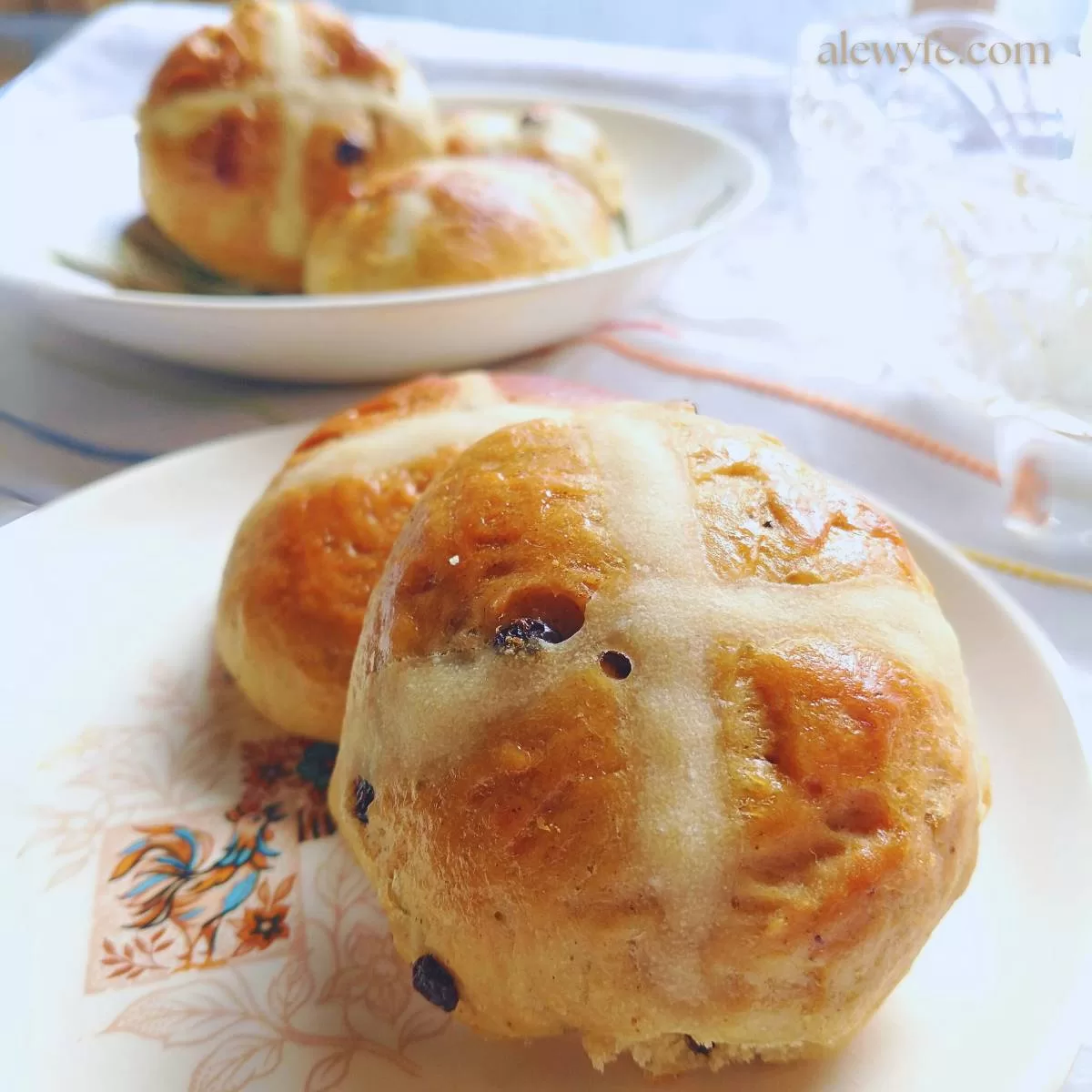BAKE: Hot Cross Buns (an Easter and springtime tradition)
- History and Symbolism of Hot Cross Buns
- Ingredients for Traditional Hot Cross Buns
- Kitchen Equipment Needed
- How to Make Hot Cross Buns
- Storage & Serving Ideas
Hot cross buns… hot cross buns… one a penny, two a penny…
Just a few notes of the nursery tune, “Hot Cross Buns” is a guaranteed recipe to strike fear and dread in the hearts (and ears) of parents of elementary school children armed with flutophones and recorders practicing the song endlessly, and as loudly as they are able, until what feels like the end of days. Are they still issuing these auditory torture devices to children? Probably! (Mom, Dad, if you’re reading this, I’m sorry)
But shrill musical earworms aside, these baked treats are actually pretty delicious. If you also didn’t grow up eating them, just being tortured by the tune (or perhaps, doing the torturing… guilty as charged), our traditional spiced hot cross buns recipe will redeem them (and you? no pun intended… ok, yes, it absolutely was. Happy Easter if you celebrate).
History and Symbolism of Hot Cross Buns
Humans have been baking bread (an often deeply symbolic food) marked with a four-quarter cross for a very, very long time, at least as early as the 6th century in Greece. The carbonized remains of a circular bread with 8 crossed markings on top were found in the ruins of Herculaneum (a neighboring city to Pompeii, buried in the same volcanic explosion in 79 AD). Similar cross-topped breads were probably also baked by ancient Saxons to celebrate the arrival of spring, with the slashed quarter markings representing quarters of the year or of the moon. We may never know the exact details of these customs, as mostly they predate the written history we have. Most of what we know is from Bede and other Anglo-Saxon scholars, and were written mostly after the earliest period of the Christianization of England, which included much syncretism with pre-Christian festivals and localized practices. The modern cross buns are decidedly Christian and a relatively recent recipe, but the symbolism is older than Christianity.
The relatively modern hot cross buns, baked on Good Friday and marking the end of Lenten fasting, are also called Albans buns. These spiced and lightly sweet rolls, often studded with currants, are believed to date to a hot cross buns recipe developed by Brother Thomas Rodcliffe at St. Albans Abbey in 1361. These spiced buns, with crosses slashed into the dough before baking, were handed out to pilgrims and visitors to the cathedral on Good Friday. They remained popular, so popular, that in Elizabethan England laws were passed to restrict when they could be baked and sold (Good Friday, Christmas, and burials). The penalty for commercial bakers breaking this law was having your expensive baked goods confiscated and donated to the needy. But now, you can find hot cross buns being sold throughout the spring season, especially in the UK or countries that were formerly under UK rule.
If you’d like to learn more about the historical origins and speculations about this traditional seasonal treat, a good place to start is this lovely short video of interviews, filmed by a historian of living history, while visiting St. Albans Cathedral.
Ingredients for Traditional Hot Cross Buns
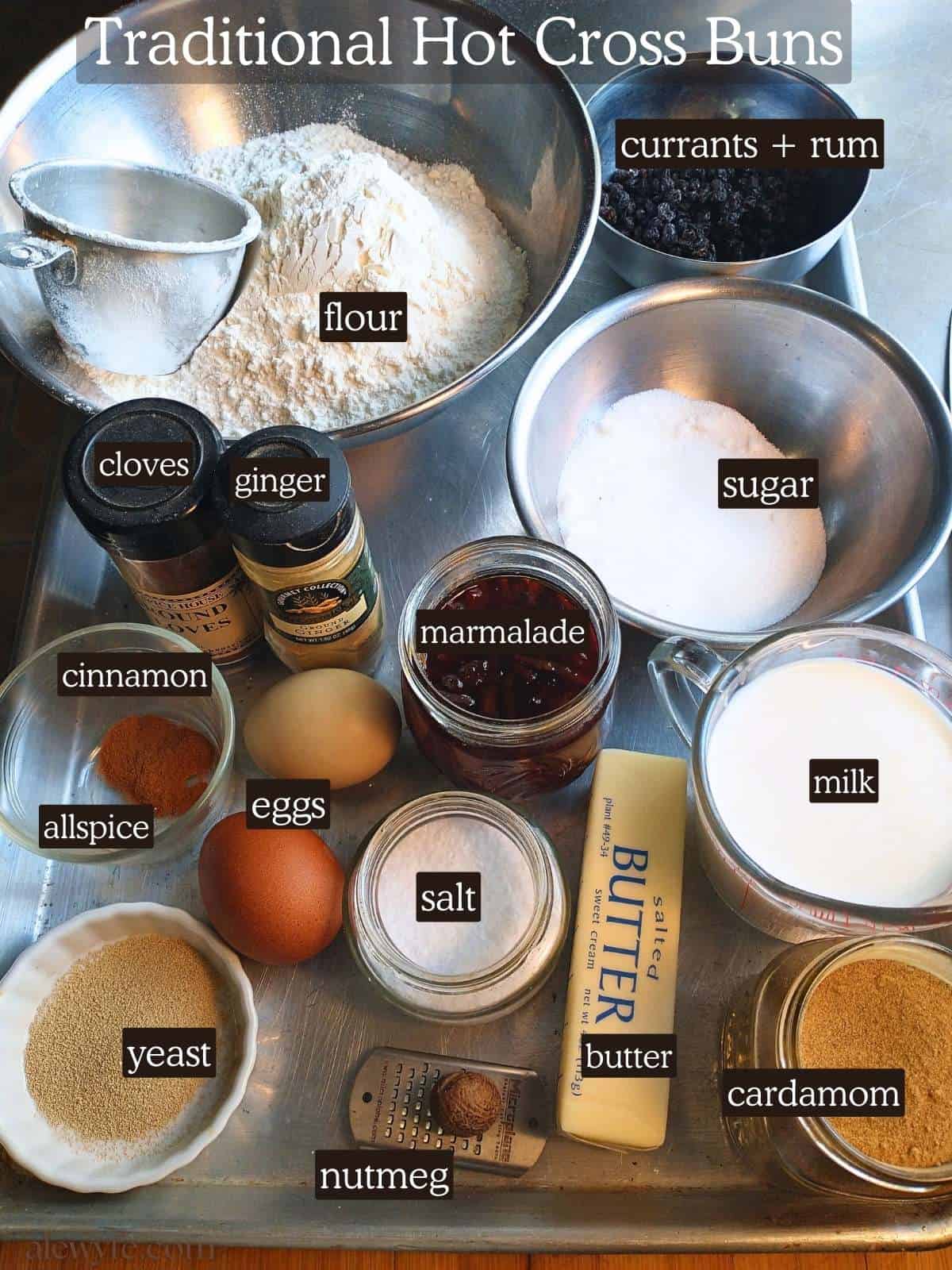
Flour:
All purpose flour will work, though your buns may be a bit denser. Bread flour, or a 50/50 mix of bread and AP flour will give you a lighter bun. You can also substitute up to half whole wheat flour. You may need to add a little extra milk, as the bran in whole wheat flour soaks up more liquid and can give you a drier dough.
Eggs:
These add richness to the buns and a tender crumb. You can use two whole eggs, or three egg yolks for an even lighter and softer roll. Save the whites for macarons or meringues!
Butter:
This also tenderizes the dough while adding a rich, buttery flavor, and helps keep the buns moist. I use salted butter. If you are using unsalted butter, increase the salt in the recipe to a teaspoon.
Milk:
Use whole milk if you have it. The extra fat will help keep your buns from being dry. The milk is scalded and then cooled to tepid before adding the yeast.
Dried Fruit & Spices:
Currants are a very traditional addition to hot cross buns. Dried currants aren’t actually currants at all, but a tiny variety of grape. You can substitute raisins or other dried fruit if you prefer, or a mixed blend. Before adding them to the dough, I like to plump my dried fruits with a little bit of rum, brandy, or bourbon. If you don’t have or don’t want to use alcohol, you can use a bit of orange juice or a few tablespoons of boiling water.
Candied citrus peel is also traditional in many hot cross bun recipes. If you don’t have any on hand or don’t want to make it, you can substitute a couple spoonfuls of chunky marmalade, or half as much freshly grated citrus zest.
If you don’t have all of the spices called for, you can substitute an equal amount of apple pie or pumpkin pie spice blend. If you want to make very authentic medieval buns, you can even add crushed or ground Grains of Paradise. These are expensive, but a little goes a long way so you can be sparing with them. You can buy them online, or from very good spice shops or homebrewing stores, as they’re often included in authentic Belgian Abbey beer recipes and spiced holiday ales. The flavor is somewhere between ginger and pepper, with fruity notes.
Yeast:
Instant dry yeast.
Kitchen Equipment Needed
Stand mixer & dough hook or large mixing bowl:
You can mix this dough by hand in a large mixing bowl, or in a sturdy stand mixer with a dough hook.
Sheet Pan:
Half sheet pans or other flat baking sheets
Piping bag and small plain tip:
The cross decoration is made from flour paste, piped on top of the proofed buns right before they go in the oven. You can also omit this step and top them with a frosting cross once they’re cooled. If you don’t have a piping bag and small tip, you can use a ziploc freezer bag with a small snip taken out of the corner.
Alternatively, you can slash the cross marks into the top of your buns. It can be difficult to get a clean cut with a kitchen knife. If you’re going this route instead of piping a cross, it’s best to use a lame, or baker’s razor with a sharp, thin blade.
How to Make Hot Cross Buns
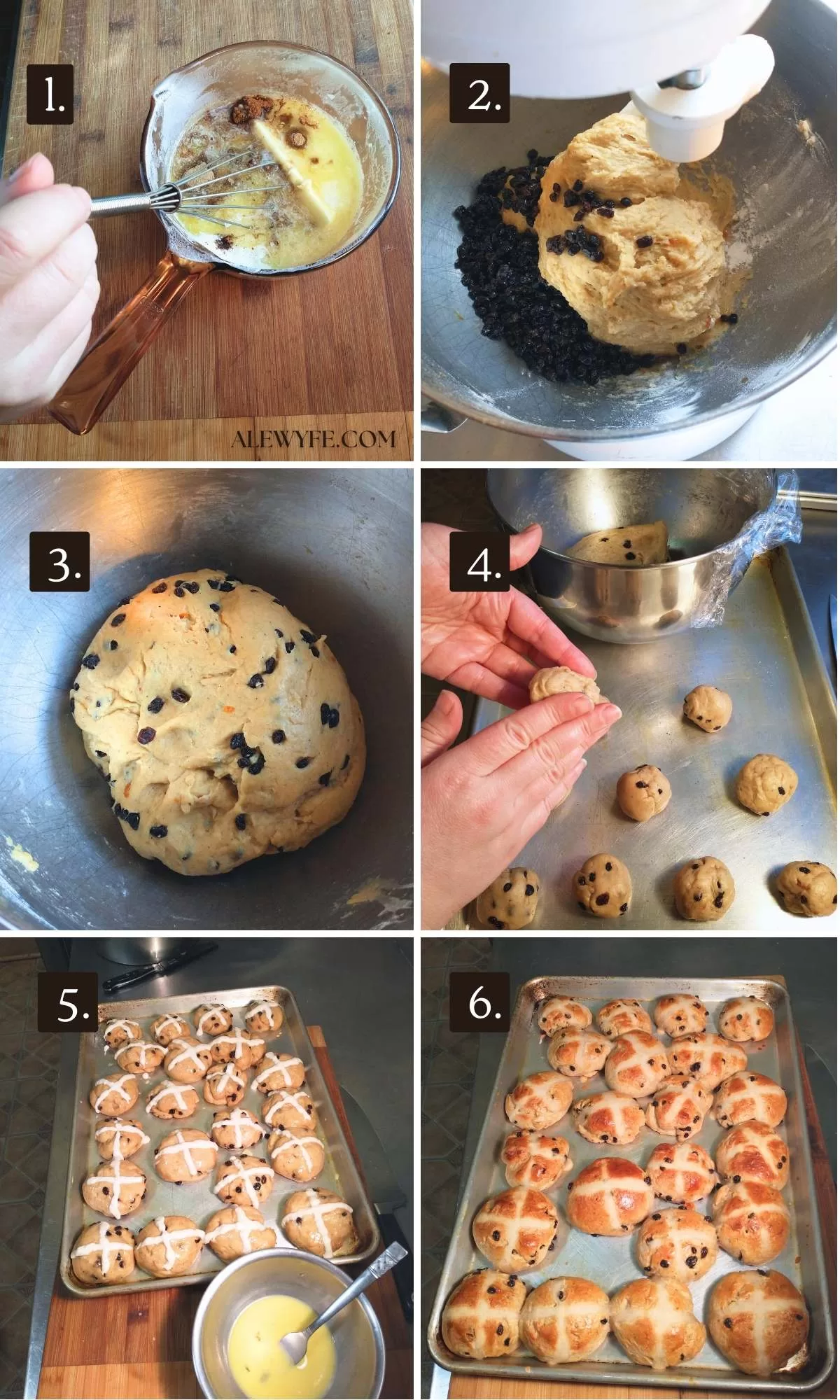
step one: prepare ingredients
- Soak the currants or dried fruit in a few tablespoons of alcohol, juice, or boiling water.
- Scald the milk, gently heating it to just under a boil.
- Remove from the heat and add the butter, sugar, marmalade, and spices to the milk.
- Stir until the butter is melted and the sugar is dissolved. Let cool until tepid/lukewarm.
step two: mix & knead dough
-
Pour the cooled milk mixture into a large mixing bowl or the bowl of a stand mixer fitted with a dough hook.
- Proof yeast – sprinkle it over the surface of the milk mixture.
-
Add half the flour, then add more a half cup at a time until the dough comes together. You may not need the last half cup of flour (use this for the cross flour paste if you already measured your ingredients).
- Mix & knead dough until it comes together into a soft dough.
- Add the soaked currants and mix until the fruit is evenly incorporated into the dough.
step three: initial bulk rise
- Transfer the dough to a lightly oiled or buttered bowl, cover tightly, and place in a warm place.
- To make ahead, you can let the dough rise overnight in the fridge. The rolls made from cold dough will take longer to rise, so give additional time for the next step if you are working with refrigerated dough.
-
Let the dough rise for about 30 minutes or until doubled. Punch down and let rise another 15 minutes.
step four: shape and proof
- Portion the dough into two to four oz balls for mini or full size buns. I made mini hot cross buns, and got about two dozen. If you prefer larger buns, you should get about a dozen from one batch.
- Shape portioned dough into balls, rolling the dough gently between cupped hands or on a clean surface, rolling and tucking the dough to form a smooth ball.
- Cover the baking sheet tightly with plastic wrap or an oiled cloth or beeswax wrap (leaving room for the buns to rise but keeping in the humidity, unless you have a humid proofing chamber, and let the buns rise.
- Proof until the rolls are roughly doubled, and lightly hold an indentation when pressed with a fingertip.
- Loudly proclaim, “He is risen!” to anyone in the kitchen… or just get the oven ready. We won’t judge (not our job, right?). Anyway. Let’s get this bread.
step five: glaze & decorate the buns
- Preheat oven to 400 F.
- Mix together the half cup of flour, sugar, and water in a small bowl to form a thick paste. You want it thick enough to cling and hold a shape briefly when piped, but not so thick that it is difficult to pipe. Add a bit more flour or water until you get a good consistency.
- Gently glaze rolls with egg wash (thinned with a few spoonfuls of milk) or melted butter.
- Pipe on the flour paste cross. Alternately, you can cut slashes in the tops of the rolls with a lame (baker’s razor) or sharp knife.
step six: bake hot cross buns
- Bake until golden brown on top, about 20-25 minutes. I like to add a pan with a handful of ice cubes to the bottom of the oven right before placing the buns in the oven. The steam they generate will help the buns to rise more before the gluten in the crust hardens, and gives a softer crust.
- Let the buns cool slightly before serving.
- Variation: decorate cooled buns with an icing cross. Do not try to ice hot buns, as the frosting will melt.
Storage & Serving Ideas
True to their name, hot cross buns are at their best fresh from the oven, piping hot. You can serve them plain, or split and spread with softened butter. They’re also delicious with marmalade butter or honey butter. You can keep them in a covered container for a few days, or freeze them for a few months once they have cooled.
Tradition holds that buns baked on Good Friday will not mold and will keep indefinitely. One was often kept hanging up somewhere in the kitchen as a good luck charm until the following year, when it would be replaced with a “currant” year’s bun. Sailors and others would take them on voyages for their protective qualities. It’s up to you if you want to test these old customs out?
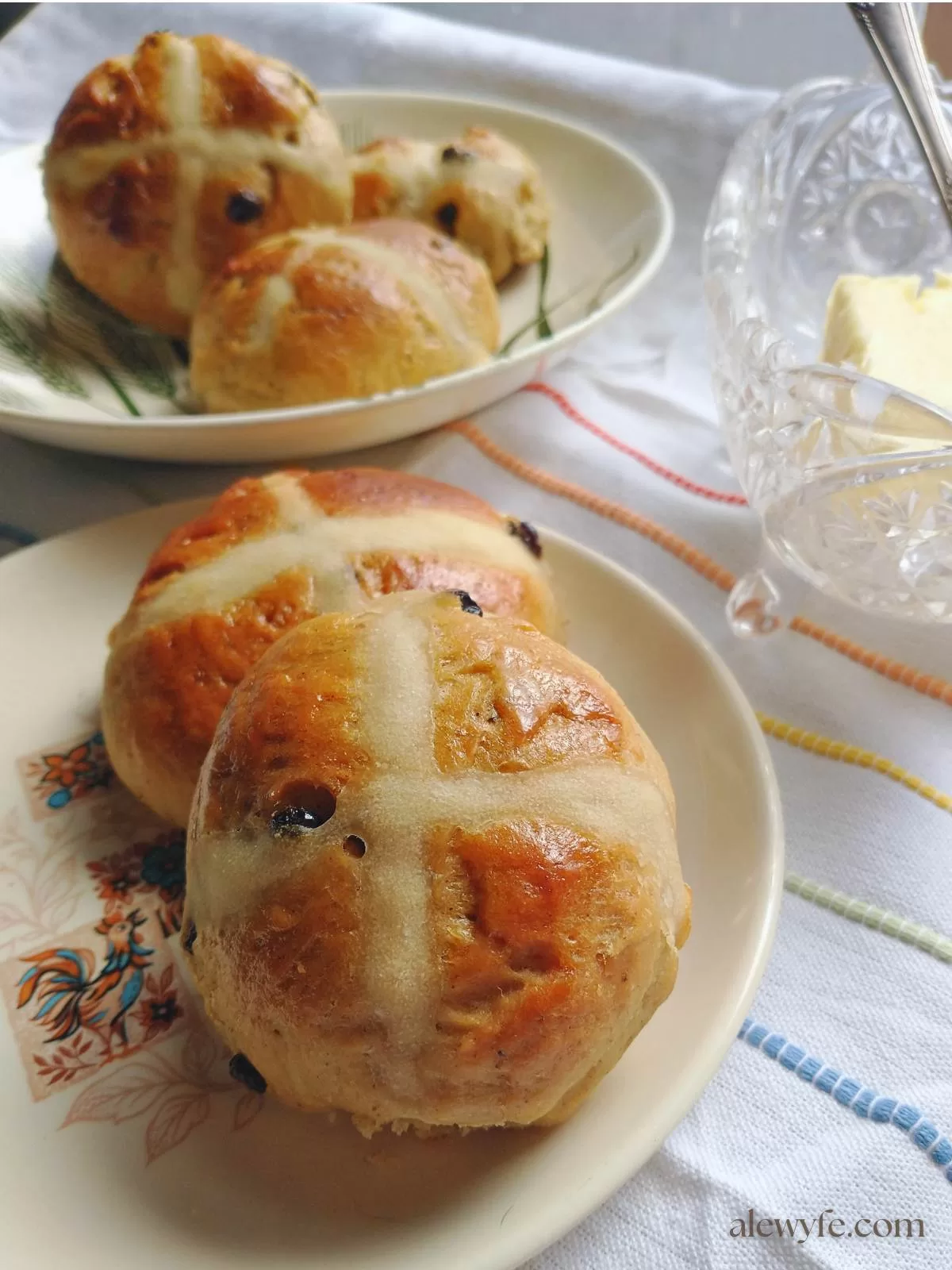
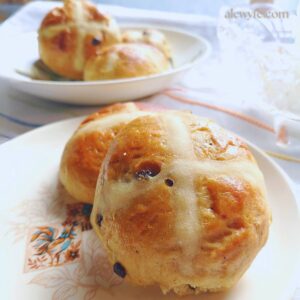
Hot Cross Buns (an Easter and springtime tradition)
Ingredients
- 4 ½ cups all purpose flour
- 1 cup whole milk
- ½ cup butter
- ½ cup white sugar
- ¾ tsp salt
- 2 tsp yeast
- 3 large eggs yolks (you can substitute two whole eggs, but your buns won't be as soft)
- ¾ cup currants (or raisins, or mixed diced dried fruit)
- 2 tbsp rum, brandy, bourbon, or orange juice (to soak the currants or raisins)
- 2 tbsp candied citrus peel or coarse marmalade
- 1 tsp ground cinnamon
- ½ tsp ground cardamom
- ½ tsp ground grains of paradise (optional)
- ½ tsp ground allspice
- ¼ tsp ground nutmeg (freshly grated if you have it)
- ¼ tsp ground cloves
Flour paste decor
- ½ cup all purpose flour
- 3 oz water ¼ cup + 2 tbsp
- 1 tbsp sugar
Instructions
Prep the Ingredients
- Soak the currants or dried fruit in a few tablespoons of alcohol, juice, or boiling water.
- Scald the milk, gently heating it to just under a boil.
- Remove from the heat and add the butter, sugar, marmalade, and spices to the milk. Stir until the butter is melted and the sugar is dissolved. Let cool until tepid/lukewarm.
Mix and Knead the Dough
- Pour the cooled milk mixture into a large mixing bowl or the bowl of a stand mixer fitted with a dough hook.
- Proof yeast – sprinkle it over the surface of the milk mixture and let rest for a few minutes or until it has dissolved.
- Add half the flour, then add more a half cup at a time until the dough comes together. You may not need the last half cup of flour (use this for the cross flour paste if you already measured your ingredients).
- Mix & knead dough until it comes together into a soft, slightly sticky dough.
- Add the soaked currants and mix until the fruit is evenly incorporated into the dough.
First Rise (bulk rise)
- Transfer the dough to a lightly oiled or buttered bowl, cover tightly, and place in a warm place.
- To make ahead, you can let the dough rise overnight in the fridge. The rolls made from cold dough will take longer to rise, so give additional time for the next step if you are working with refrigerated dough.
- Let the dough rise for about 30 minutes or until doubled. Punch down and let rise another 15 minutes.
Shape and Proof the Buns
- Portion the dough into two to four ounce balls for mini or full size buns.
- Shape into balls, rolling the dough gently between cupped hands or on a clean surface, rolling and tucking the dough to form a smooth ball.
- Cover the baking sheet tightly with plastic wrap or an oiled cloth or beeswax wrap (leaving room for the buns to rise but keeping in the humidity, unless you have a humid proofing chamber, and let the buns rise.
- Proof until the rolls are roughly doubled, and lightly hold an indentation when pressed with a fingertip.
- While the rolls are rising, mix together the half cup of flour, sugar, and water in a small bowl to form a thick paste. You want it thick enough to cling and hold a shape briefly when piped, but not so thick that it is difficult to pipe. Add a bit more flour or water until you get a good consistency.
Decorate and Bake
- Preheat oven to 400 F.
- Gently glaze rolls with egg wash (thinned with a few spoonfuls of milk) or melted butter.
- Pipe on the flour paste cross. Alternately, you can cut slashes in the tops of the rolls with a lame (baker’s razor) or sharp knife.
- Bake until golden brown on top, about 20-25 minutes. I like to add a pan with a handful of ice cubes to the bottom of the oven right before placing the buns in the oven. The steam they generate will help the buns to rise more before the gluten in the crust hardens, and gives a softer crust.
- Let the buns cool slightly before serving.
Notes
